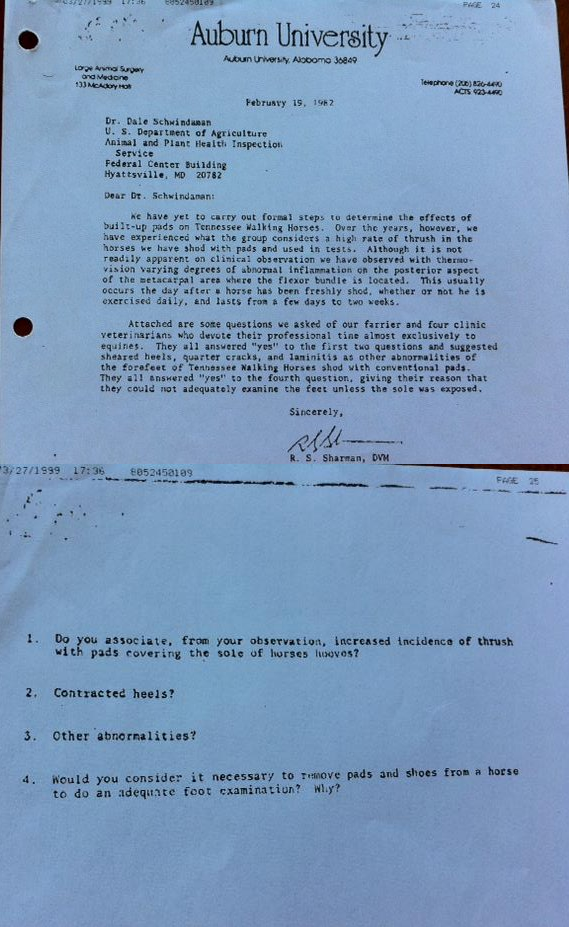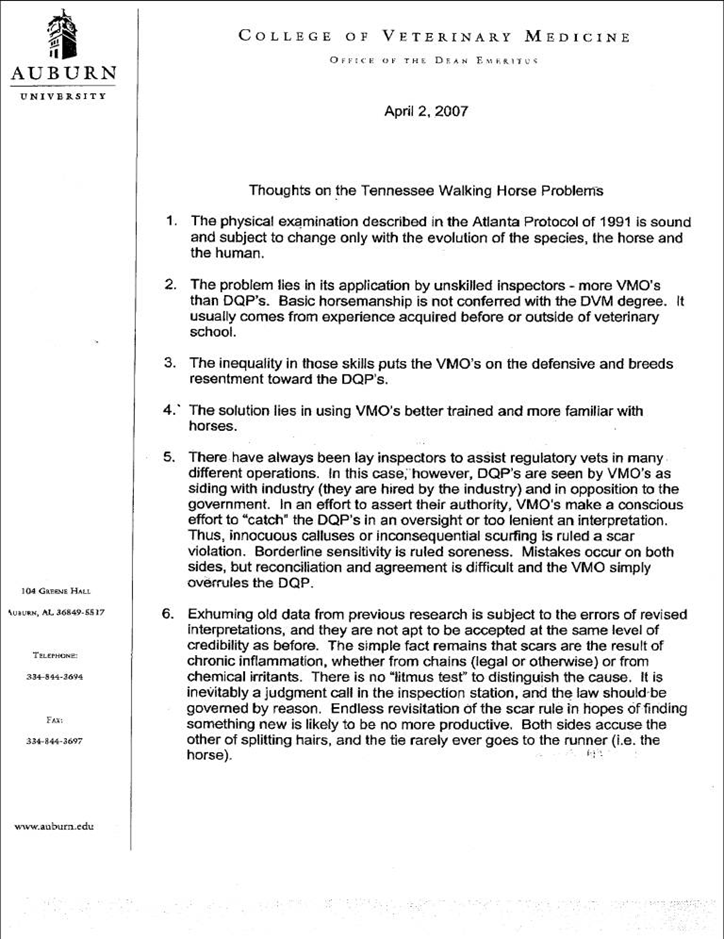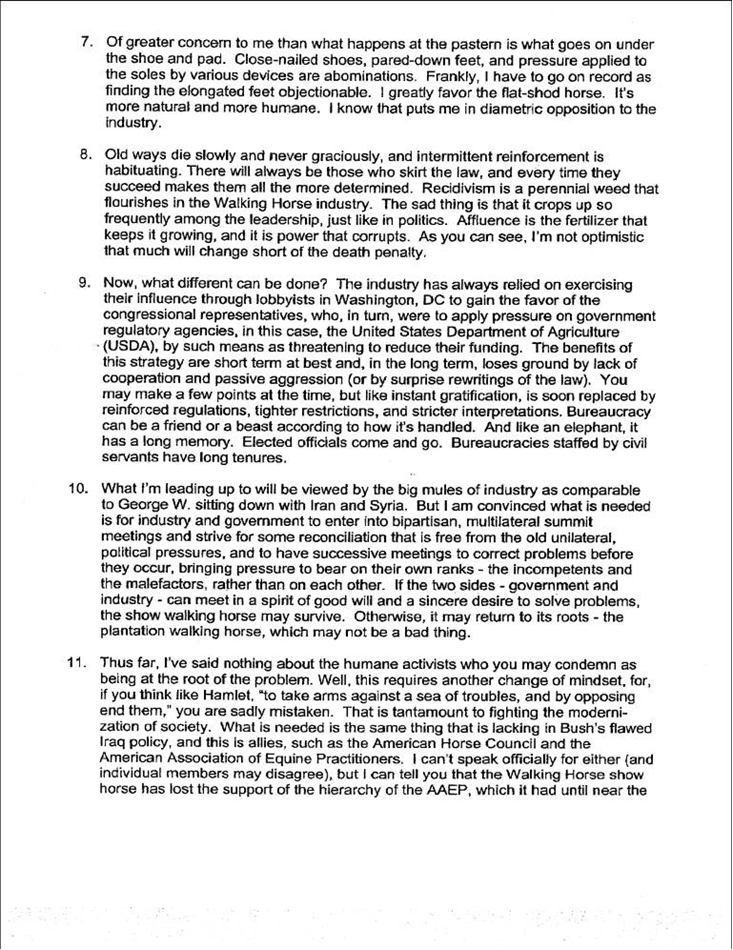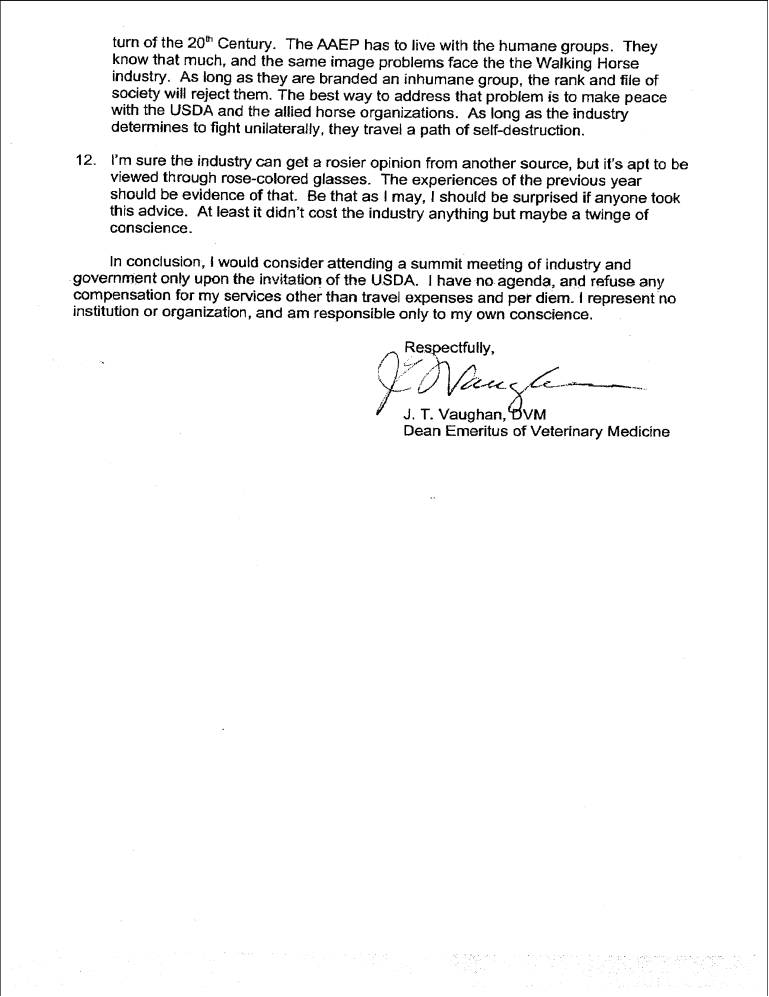I don't know if I had posted this yet or not, but I finally received the letter that went with the Auburn Study of 1982. If you haven't read what I've written about the Auburn Study, you can read it here.
Below is a jpg image of the letter. In case you can't read it, I copied what it says verbatim below the jpgs.

**********
February 19, 1982
February 19, 1982
Dear Dr. Schwindaman:
We have yet to carry out the formal steps to determine the effects of built-up pads on Tennessee Walking Horses. Over the years, however, we have experienced what the group considers a high rate of thrush in the horses we have shod with pads and used in tests. Although it is not readily apparent on clinical observation we have observed with thermovision varying degrees of abnormal inflammation on the posterior aspect of the metacarpal area where the flexor bundle is located. This usually occurs the day after a horse has been freshly shod, whether or not he is exercised daily, and lasts from a few days to two weeks.
Attached are some questions we asked of our farrier and four clinic veterinarians who devote their professional time almost exclusively to equines. They all answered 'yes' to the first two questions and suggested sheared heels, quarter cracks, and laminitis as other abnormalities of the forefeet of Tennessee Walking Horses shod with conventional pads. They all answered 'yes' to the fourth question, giving their reason that they could not adequately examine the feet unless the sole was exposed.
Sincerely,
R.S. Sharman, DVM
Assistant Professor
1. Do you associate , from your observation, increased incidence of thrush with pads covering the sole of horses hooves? [YES]
2. Contracted Heels? [YES]
3. Other abnormalities? [YES - sheared heels, quarter cracks and laminitis]
4. Would you consider it necessary to remove pads and shoes from a horse to do an adequate foot examination? Why? [YES - The foot cannot be adequately examined without the sole exposed.]
**********
I really don't understand how this can't be considered evidence that pads are bad. This industry continues to kid itself...will they ever learn? Well, I think we know the answer to that one.
Auburn University Letter 2007
In 2007, Dr. J.T. Vaughan wrote the following letter to the TWH industry. He was one of the original vets who worked on the Auburn Study, which included the cover letter above. He was also one of the drafters of the Atlanta Protocol of 1991, which basically was an attempt to overthrow the HPA that fizzled. The courts recognized that the Atlanta Protocol was a farce; excerpt: "The general consensus of the July 24, 1991, meeting (RX 4) [aka Altanta Protocol] is, in effect, a prescription for repealing the Horse Protection Act, while leaving in its place a facade to give lip-service to the purposes of the Horse Protection Act. If the Department were to accede to the principles set forth in RX 4, soring, as it exists today, could be practiced virtually with impunity." Click here to read the case itself; quote is from page 34.
However, Mr. Vaughan has certainly seen the industry for what it is. He certainly still holds true to the facts that were found in the Auburn Study. His points are
Here are the thumbnails from the letter in three pages so you can see they're real. If you click on the thumbnail, it will take you to the letter on the FTTWH Photobucket page.
Here's the text of the letter verbatim. Honestly, I think the entire letter speaks for itself and Dr. Vaughan clearly wants to see a sound, natural, FS horse in the ring. He points out that the problem is the politics and the continued need for power and money and there is no concern for the welfare of the horse. This is a great letter that really deserves more attention.
**********
Auburn University
College of Veterinary Medicine
Office of the Dean Emeritus
April 2, 2007
Thoughts on the Tennessee Walking Horse Problems
1. The physical examination described in the Atlanta Protocol of 1991 is sound and subject to change only with the evolution of the species, the horse and the human.
2. The problem lies in its application by unskilled inspectors - more VMOs than DQPs. Basic horsemanship is not conferred with the DVM degree. It usually comes from experience acquired before or outside of veterinary school.
3. The inequality in those skills puts the VMOs on the defensive and breeds resentment toward the DQPs.
4. The solution lies in using VMOs better trained and more familiar with horses.
5. There have always been lay inspectors to assist regulatory vets in many different operations. In this case, however, DQPs are seen by VMOs as siding with the industry (they are hired by the industry) and in opposition to the government. In an effort to assert their authority, VMOs make a conscious effort to "catch" the DQPs in an oversight or too lenient an interpretation. Thus, innocuous calluses or inconsequential scurfing is ruled a scar violation. Borderline sensitivity is ruled soreness. Mistakes occur on both sides, but reconciliation and agreement is difficult and the VMO simply overrules the DQP.
6. Exhuming old data from previous research is subject to the errors of revised interpretations, and they are not apt to be accepted at the same level of credibility as before. The simple fact remains that scars are the result of chronic inflammation, whether from chains (legal or otherwise) or from chemical irritants. There is no "litmus test" to distinguish the cause. It is inevitably a judgment call in the inspection station, and the law should be governed by reason. Endless revisitation of the scar rule in hope of finding something new is likely to be no more productive. Both sides accuse the other of splitting hairs, and the tie rarely ever goes to the runner (i.e., the horse).
7. Of greater concern to me than what happens at the pastern is what goes on under the shoe and pad. Close-nailed shoes, pared-down feet, and pressure applied to the soles by various devices are abominations. Frankly, I have to go on record as finding the elongated feet objectionable. I greatly favor the flat-shod horse. It's more natural and more humane. I know that puts me in diametric opposition to the industry.
8. Old ways die slowly and never graciously, and intermittent reinforcement is habituating. There will always be those who skirt the law, and every time they succeed makes them all the more determined. Recidivism is a perennial weed that flourishes in the Walking Horse industry. The sad thing is that it crops up so frequently among the leadership, just like in politics. Affluence is the fertilizer that keeps it growing, and it is power that corrupts. As you can see, I'm not optimistic that much will change sort of the death penalty.
9. Now what difference can be done? The industry has always relied on exercising their influence through lobbyists in Washington, DC to gain the favor of the congressional representatives, who, in turn, were to apply pressure on government regulatory agencies, in this case, the United States Department of Agriculture (USDA), by such means as threatening to reduce their funding. The benefits of this strategy are short term at best and, in the long term, loses ground by lack of cooperation and passive aggression (or by surprise rewritings of the law). You may make a few points at the time, but like instant gratification, it is soon replaced by reinforced regulations, tighter restrictions, and stricter interpretations. Bureaucracy can be a friend or a beast according to how it's handled. And like an elephant, it has a long memory. Elected officials come and go. Bureaucracies staffed by civil servants have long tenures.
10. What I'm leading up to will be viewed by the big mules of industry as comparable to George W. sitting down with Iran and Syria. But I am convinced what is needed is for industry and government to enter into bipartisan, multilateral summit meetings and strive for some reconciliation that is free from the old unilateral, political pressures, and to have successive meetings to correct problems before they occur, bringing pressure to bear on their own ranks - the incompetents and the malefactors, rather than on each other. If the two sides - government and industry - can meet in a spirit of good will and a sincere desire to solve problems, the show walking horse may survive. Otherwise, it may return to its roots - the plantation walking horse, which may not be a bad thing.
11. Thus far, I've said nothing about the humane activists who you may condemn as being at the root of the problem. Well, this requires another change of mindset, for, if you think like Hamlet, "to take arms against a sea of troubles, and by opposing end them," you are sadly mistaken. That is tantamount to fighting the modernization of society. What is needed is the same thing that is lacking in Bush's flawed Iran policy, and this is allies, such as the American Horse Council and the American Association of Equine Practitioners. I can't speak officially for either (and individual members may disagree), but I can tell you that the Walking Horse show horse has lost the support of the hierarchy of the AAEP, which it had until near the turn of the 20th Century. The AAEP has to live with the humane groups. They know that much, and the same image problems face the Walking Horse industry. As long as they are branded an inhumane group, the rank and file of society will reject them. The best way to address that problem is to make peace with the USDA and the allied horse organizations. As long as the industry determines to fight unilaterally, they travel a path of self-destruction.
12. I'm sure the industry can get a rosier opinion from another source, but it's apt to be viewed through rose-colored glasses. The experiences of the previous year should be evidence of that. Be that as it may, I should be surprised if anyone took this advice. At least it didn't cost the industry but maybe a twinge of conscience.
In conclusion, I would consider attending a summit meeting of industry and government only upon the invitation of the USDA. I have no agenda, and refuse any compensation for my services other than travel expenses and per diem. I represent not institution or organization, and am responsible only to my own conscience.
Respectfully,
Dr. J.T. Vaughan, DVM
Dean Emeritus of Veterinary Medicine
I really don't understand how this can't be considered evidence that pads are bad. This industry continues to kid itself...will they ever learn? Well, I think we know the answer to that one.
Auburn University Letter 2007
In 2007, Dr. J.T. Vaughan wrote the following letter to the TWH industry. He was one of the original vets who worked on the Auburn Study, which included the cover letter above. He was also one of the drafters of the Atlanta Protocol of 1991, which basically was an attempt to overthrow the HPA that fizzled. The courts recognized that the Atlanta Protocol was a farce; excerpt: "The general consensus of the July 24, 1991, meeting (RX 4) [aka Altanta Protocol] is, in effect, a prescription for repealing the Horse Protection Act, while leaving in its place a facade to give lip-service to the purposes of the Horse Protection Act. If the Department were to accede to the principles set forth in RX 4, soring, as it exists today, could be practiced virtually with impunity." Click here to read the case itself; quote is from page 34.
However, Mr. Vaughan has certainly seen the industry for what it is. He certainly still holds true to the facts that were found in the Auburn Study. His points are
Here are the thumbnails from the letter in three pages so you can see they're real. If you click on the thumbnail, it will take you to the letter on the FTTWH Photobucket page.
 |
| Page 1 |
 |
| Page 2 |
 |
| Page 3 |
Here's the text of the letter verbatim. Honestly, I think the entire letter speaks for itself and Dr. Vaughan clearly wants to see a sound, natural, FS horse in the ring. He points out that the problem is the politics and the continued need for power and money and there is no concern for the welfare of the horse. This is a great letter that really deserves more attention.
**********
Auburn University
College of Veterinary Medicine
Office of the Dean Emeritus
April 2, 2007
Thoughts on the Tennessee Walking Horse Problems
1. The physical examination described in the Atlanta Protocol of 1991 is sound and subject to change only with the evolution of the species, the horse and the human.
2. The problem lies in its application by unskilled inspectors - more VMOs than DQPs. Basic horsemanship is not conferred with the DVM degree. It usually comes from experience acquired before or outside of veterinary school.
3. The inequality in those skills puts the VMOs on the defensive and breeds resentment toward the DQPs.
4. The solution lies in using VMOs better trained and more familiar with horses.
5. There have always been lay inspectors to assist regulatory vets in many different operations. In this case, however, DQPs are seen by VMOs as siding with the industry (they are hired by the industry) and in opposition to the government. In an effort to assert their authority, VMOs make a conscious effort to "catch" the DQPs in an oversight or too lenient an interpretation. Thus, innocuous calluses or inconsequential scurfing is ruled a scar violation. Borderline sensitivity is ruled soreness. Mistakes occur on both sides, but reconciliation and agreement is difficult and the VMO simply overrules the DQP.
6. Exhuming old data from previous research is subject to the errors of revised interpretations, and they are not apt to be accepted at the same level of credibility as before. The simple fact remains that scars are the result of chronic inflammation, whether from chains (legal or otherwise) or from chemical irritants. There is no "litmus test" to distinguish the cause. It is inevitably a judgment call in the inspection station, and the law should be governed by reason. Endless revisitation of the scar rule in hope of finding something new is likely to be no more productive. Both sides accuse the other of splitting hairs, and the tie rarely ever goes to the runner (i.e., the horse).
7. Of greater concern to me than what happens at the pastern is what goes on under the shoe and pad. Close-nailed shoes, pared-down feet, and pressure applied to the soles by various devices are abominations. Frankly, I have to go on record as finding the elongated feet objectionable. I greatly favor the flat-shod horse. It's more natural and more humane. I know that puts me in diametric opposition to the industry.
8. Old ways die slowly and never graciously, and intermittent reinforcement is habituating. There will always be those who skirt the law, and every time they succeed makes them all the more determined. Recidivism is a perennial weed that flourishes in the Walking Horse industry. The sad thing is that it crops up so frequently among the leadership, just like in politics. Affluence is the fertilizer that keeps it growing, and it is power that corrupts. As you can see, I'm not optimistic that much will change sort of the death penalty.
9. Now what difference can be done? The industry has always relied on exercising their influence through lobbyists in Washington, DC to gain the favor of the congressional representatives, who, in turn, were to apply pressure on government regulatory agencies, in this case, the United States Department of Agriculture (USDA), by such means as threatening to reduce their funding. The benefits of this strategy are short term at best and, in the long term, loses ground by lack of cooperation and passive aggression (or by surprise rewritings of the law). You may make a few points at the time, but like instant gratification, it is soon replaced by reinforced regulations, tighter restrictions, and stricter interpretations. Bureaucracy can be a friend or a beast according to how it's handled. And like an elephant, it has a long memory. Elected officials come and go. Bureaucracies staffed by civil servants have long tenures.
10. What I'm leading up to will be viewed by the big mules of industry as comparable to George W. sitting down with Iran and Syria. But I am convinced what is needed is for industry and government to enter into bipartisan, multilateral summit meetings and strive for some reconciliation that is free from the old unilateral, political pressures, and to have successive meetings to correct problems before they occur, bringing pressure to bear on their own ranks - the incompetents and the malefactors, rather than on each other. If the two sides - government and industry - can meet in a spirit of good will and a sincere desire to solve problems, the show walking horse may survive. Otherwise, it may return to its roots - the plantation walking horse, which may not be a bad thing.
11. Thus far, I've said nothing about the humane activists who you may condemn as being at the root of the problem. Well, this requires another change of mindset, for, if you think like Hamlet, "to take arms against a sea of troubles, and by opposing end them," you are sadly mistaken. That is tantamount to fighting the modernization of society. What is needed is the same thing that is lacking in Bush's flawed Iran policy, and this is allies, such as the American Horse Council and the American Association of Equine Practitioners. I can't speak officially for either (and individual members may disagree), but I can tell you that the Walking Horse show horse has lost the support of the hierarchy of the AAEP, which it had until near the turn of the 20th Century. The AAEP has to live with the humane groups. They know that much, and the same image problems face the Walking Horse industry. As long as they are branded an inhumane group, the rank and file of society will reject them. The best way to address that problem is to make peace with the USDA and the allied horse organizations. As long as the industry determines to fight unilaterally, they travel a path of self-destruction.
12. I'm sure the industry can get a rosier opinion from another source, but it's apt to be viewed through rose-colored glasses. The experiences of the previous year should be evidence of that. Be that as it may, I should be surprised if anyone took this advice. At least it didn't cost the industry but maybe a twinge of conscience.
In conclusion, I would consider attending a summit meeting of industry and government only upon the invitation of the USDA. I have no agenda, and refuse any compensation for my services other than travel expenses and per diem. I represent not institution or organization, and am responsible only to my own conscience.
Respectfully,
Dr. J.T. Vaughan, DVM
Dean Emeritus of Veterinary Medicine

No comments:
Post a Comment